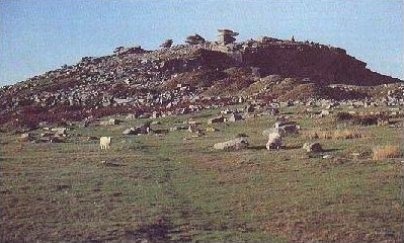
Bodmin Moor
Goon Brenn
Cornwall's Ancient Moor
Web: www.bodminmoor.co.uk
Web: www.visitcornwall.com/regions/bodmin-moor
Map
A large tract of beautiful, windswept countryside, rich in history and legend, lying empty and almost unknown in the middle of England's most popular holiday county. It is 80 square miles in size, and dates from the Carboniferous period of geological history.
Bodmin Moor (originally known as Fowey Moor) with its rolling landscapes with dramatic granite outcrops have led to it being designated an Area of Outstanding Natural Beauty, about 100 square miles in area. Particularly well known to visitors to Cornwall today, because the A30 which cuts right across the moor from north-east to south-west, was originally built as a toll road in the 1770's is the main road in to Cornwall.
Most of the moor lies above 800 feet, and the highest point, also the highest point in Cornwall, is Brown Willy at 1377 feet, with Roughtor at 1311 feet. Both can be reached after a brisk walk from the nearest car park at the end of the road from Camelford. Cornwall's two most important rivers, the Camel and the Fowey, both rise on the Moor. And there are three reservoirs, Colliford, Crowdy and Siblyback which supply water for a large part of the county's population. The legendary Dozmary Pool is just south of Bolventor. Considerable areas of the moor are poorly drained and form marshes. The rest of the moor is mostly rough pasture or overgrown with heather and other low vegetation.
There are several small villages on or around the moor, some are ancient hamlets, and others which appeared during the mining boom. Surrounding the moor are the larger towns of Camelford, Launceston, Callington, Liskeard and Bodmin.
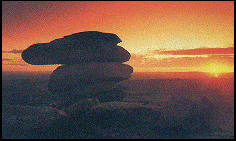
Bodmin Moor has been at the heart of all that is Cornwall since man made his first primitive home here almost 7,000 years ago. For the visitor with sufficient time, and the interest to seek it out, history lies on every rocky tor, and lurks in each lonely valley, side-by-side with romance and legend. There can be few visitors to Cornwall who have not seen this expanse of granite upland. Approached from the east, its dark heights dominate the horizon. The rugged, boulder-strewn tors have changed little over the centuries. Stone Age man; Roman trader; Dark Age Saint; Saxon Chieftain; Norman Earl; Medieval farmer - even King Arthur himself - would feel at home were they to return to the heart of the moor today. This sense of timelessness is felt by all who come to know and love Bodmin Moor. To strike out across the coarse grass, leaving behind the grey stone moor-side hamlets, is to stride back into Cornwall's History. Almost every age of man has left its brief mark here and the moor is littered with ancient sites. There are old tin streaming works, granite quarries which have supplied major constructions all over the country, and the remains of tin and copper mines which have earned fortunes for the miners.
A phantom wild cat purported to live on Bodmin Moor became a centre of many sightings with occasional reports of mutilated slain livestock: the alleged panther-like cats of the region came to be popularly known as the Beast of Bodmin Moor.
Towns and Villages
Altarnun
Charming Bodmin Moor village located four miles north-east of Bolventor on the A30 road, in the steep sided valley of Penpont Water, with 15th century packhorse bridge and outstanding parish church of St. Nonna, known as 'Cathedral of the Moors'.
Blisland
Classic moorland village, set high on the western edge of Bodmin Moor, with village green and part-Norman parish church of St. Protus and St. Hyacinth, described by Sir John Betjeman as 'dazzling and amazing'. Just one mile north is the massive Jubilee Rock, carved with a figure of Britannia, coats of arms and other symbols to mark the Golden Jubilee of George III in 1810. Also nearby is a Neolithic stone circle known as the Stripple Stones, and two stone bridges across the De Lank river, Delphi and Bradford. Local pub is The Blisland Inn.
Bodmin
Set in the centre of the county. Notable 15th century St. Petroc's parish church, the largest in Cornwall, with remains of monastery and priory; also Tudor Guildhall. For a century and a half Cornwall's county town. One of the leaders of the 1497 Cornish Rebellion, the lawyer Thomas Flamank, came from here. Bodmin Jail, scene of many public executions. Regimental Museum, Duke of Cornwall's Light Infantry. Great houses of Lanhydrock and Pencarrow. Bodmin and Wenford Steam Railway. Access to the Camel Trail. Main line railway station.
Bolventor
Truly a high moorland village, it is situated in the very heart of the moor on the A30 road. Here is the old coaching house Jamaica Inn made famous by Daphne du Maurier's novel. The small church that was built by the Rodd's of Trebartha and dedicated to the Holy Trinity that lies to the west of the village closed some years ago. Colliford Lake Park and Bodmin airfield at nearby Cardinham. Walks to Dozmary Pool and Brown Willy.
Bowithick
Small hamlet high on Bodmin Moor near Davidstow Airfield. There is a ford and a bridge across Penpont Water. Good access point for the northern moors with some parking.
Callington
Market town nestling between Tamar and Lynher rivers on the cross roads of the A390 and the A388. Once a prosperous mining and woollen centre. 15th century chapel encloses Dupath Well, with reputation for curing whooping cough. 1000 foot high Kit Hill to north, with nature trails and spectacular views of Bodmin Moor and Dartmoor.
Camelford
A small town on the main A39 trunk road, which takes its name form the river which flows through it. Suffers from a high rainfall due to the close proximity to the western edge of Bodmin Moor. Ideal touring centre. Tintagel, to north, is the legendary castle of King Arthur, and nearby Slaughterbridge over the River Camel is probable site of bloody defeat of Cornish by Wessex. Site of North Cornwall Museum and Art Gallery, and nearby is the British Cycling Museum. Also in the area is Crowdy Reservoir for trout fishing.
Cardinham
On western slopes of Bodmin Moor, surrounded by moorland and steep wooded valleys. This little known village boasts a fine 15th century church dedicated to St. Meubred, in which is a brass commemorating Thomas Awmarle, a Rector of the parish in the 14th century, and two of Cornwall's finest Celtic crosses in the churchyard, one of which is well over 8 feet tall and beautifully decorated. Cardinham Castle is a large 11th century earth ringwork mound of what was once a motte and bailey castle. Well situated for Bodmin airfield, Carnglaze Slate Caverns and moor.
Common Moor
Moorland village dating back to the mining boom, founded by the Davy family, traces of its past are still visible from placenames like "Davy's Row". It sits about a mile north of St Cleer, and is close to Siblyback Lake. It does not have a public telephone box or post office but does have a letter box. It is an enviable place in which to live. Being in a cul-de-sac which leads only on to the moors.
Crows Nest
Small mining village on the southern slopes of Bodmin Moor. About four miles north of Liskeard. Once housed miners from the nearby Caradon Hill mines. The stream that starts from just above the village becomes the River Seaton. A large Methodist chapel was built here to tame the miners (now demolished) and Crows Nest Inn.
Darite
Old mining village five miles north of Liskeard on the southern edge of Caradon Hill and Bodmin Moor. Once on the Liskeard to Caradon Railway. Still has a small Methodist chapel.
Darleyford
Between Liskeard and Launceston on the B3254. Site of a 1000 year old oak tree associated with a considerable amount of legends.
Henwood
Very old village on the edge of Bodmin Moor, north of Minions, under the shadow of Sharptor. There is no church here but there is a chapel which is now nearly 150 years old. The village was here long before the nearby mines and the family bearing the name of Henwood still live in the parish and are able to trace their ancestry back for hundreds of years.
Launceston
Main town in north Cornwall, dominated by a Norman keep, the 'Castle Terrible' of Malory's Morte d'Arthur, built by Robert of Mortain. Outer and inner baileys of 12th and 13th centuries. Capital of Cornwall until 1838. St. Mary Magdalene church features exquisite carvings. Steam railway. Nearby, Tamar Otter Sanctuary, Trethorne Leisure Farm and Lakeside Gallery.
Linkinhorne
North-west of Callington. The church of St. Melor has a magnificent granite tower 120 feet tall. Birthplace of Daniel Gumb who lived in a cave close to the Cheesewring. Local pub is the Church House Inn.
Liskeard
Busy market town in the east of the county, once linked by canal to Looe and now by-passed by the A38. St. Martins church, Guildhall and Stuart House of interest, 16th century Pipe Well. Nearby, St. Keyne Well, mechanical music museum, and Dobwalls Family Adventure Park. Main line railway station with a scenic branch line to Looe.
Minions
Bodmin Moor hamlet, once the centre of mining activity, and with a railway running the village, it now boasts to have the highest pub in Cornwall (The Cheesewring Hotel) at over 1000 feet above sea level, The setting of E V Thompson's historical novel 'Chase the Wind', a century ago the area would have been teeming with miners and quarrymen seeking granite, copper and lead, but today the nearby Cheesewring Quarry is deserted except for rock climbers. On the edge of the quarry stands the Cheesewring itself, an extraordinary natural tor formed from precariously balanced rocks. Bronze Age stone circles and mine ruins nearby. One of the engine houses of the South Phoenix Mine has been converted into The Minions Heritage Centre.
North Hill
Fine moorland village on the eastern edge of Bodmin Moor high above the River Lyhner. Inside the 14th century church are a number of fine monuments to the Spoure family who occupied nearby Trebartha Manor for almost 250 years. Local pub is The Racehorse Inn.
Pensilva
A large village on the edge of Bodmin Moor. Originally built as local housing for the many nearby mines. Still has shops, a pub (The Victoria Inn) and buses to Liskeard etc.
St. Breward
High moorland village situated on the western edge of Bodmin moor. Once known as Simonward, after Simon Ward the brewer to King Arthur's Court! The 15th century church here, claims to be sited higher than any other church in the county. The village's only pub, The Old Inn, has stood on the site since the 11th century. Nearby is an old clapper bridge over the De Lank River. Stone hewn from the De Lank Quarry was also used to construct some important landmarks such has the Eddystone Lighthouse, built in 1882, the Beachy Head Lighthouse, built in 1900, and of course London's Tower Bridge which was built in 1890.
St. Cleer
Bodmin Moor village, built to house the mine workers during the copper mining boom. Three miles north of Liskeard, with 15th century church and enclosed well. Neolithic Trethevy Quoit, inscribed King Doniert's Stone, Siblyback Lake and Golitha Falls beauty spot nearby.
St. Clether
Small hamlet situated between Launceston and Camelford just south of the A395 in the scenic River Inny Valley. The original Norman church of St. Clederus was, apart from the tower, rebuilt in 1865. It also has a beautifully situated Holy Well dedicated to Saint Cleder, dating back to Celtic times.
St. Neot
Small village on the southern edge of Bodmin Moor in a wooded valley. Once thriving on wool, now famed for 15th century church with magnificent stained glass. To this day an oak branch can be seen decorating the top of the church tower, celebrating King Charles escape from the Puritans by hiding in an oak tree. The branch is renewed every year on oak apple day, 29th May. Carnglaze Slate Caverns, Colliford Lake Park nearby.
Temple
Once the Gretna Green of Cornwall, earning much of its income from marriages and burials. This settlement high on Bodmin Moor, just off the A30 road was founded by the Knights Templar in 1120 as a hospice for travellers. The little church built by the Knights fell into disrepair many years ago, but was re-built in 1883 on the original pattern as St. Catherine's by Silvanus Trevail. It is a stark little building, tucked away in a quiet valley but still serving its sparse community.
Tremar
Two miles north of Liskeard. It was largely constructed during the mid-nineteenth century to accommodate workers at nearby mines and quarries and their families. From the early 1960's to the 1980's, it was the home of Tremar Pottery.
Upton Cross
North of Liskeard on the B3254. Old mining village on the edge of Bodmin Moor. Well known for its pub, The Caradon Inn. The spire-less church of St. Paul was built in 1887. The Sterts Open Air Theatre is nearby.
Warleggan
An ancient moorland settlement about two miles west of St. Neot, with a very old church, parts of which date from the 12th century. Best known for the eccentric Reverend Frederick Densham, who became parish priest in 1931. Disliked by his parishioners, Densham shut himself off from the world and kept the remote church of St. Bartholomew locked most of the time. He preached to a congregation of cardboard images, propped up in the pews. He died alone in 1953 in his vicarage, which he is now said to haunt. Was once a busy Bodmin Moor village with the local mines and quarries employing hundreds of people. A road was built in 1953 linking Warleggan to the A38 road; until then it had been regarded as one of the most remote areas of Cornwall.
Places of Interest
Brown Gelly Brown Willy Caradon Hill The Cheesewring Colliford Lake Crowdy Reservoir
Dozmary Pool Daniel Gumb's Cave Fore Down Fox Tor Garrow Tor Golitha Falls The Hurlers Jubilee Rock Kerdroya
Kilmar Tor King Arthur's Bed King Arthurs's Hall King Doniert's Stone Nine Stones The Longstone Rillaton Barrow Rough Tor
Sharptor Siblyback Reservoir Stowe's Pound Temple Church Tregarrick Tor Trethevy Quiot Trewortha Bronze Age Farm
Craddock Moor Stone Circle Fernacre Stone Circle Goodaver Stone Circle Leaze Stone Circle Leskernick Quoit Leskernick Stone Circle
Louden Hill Stone Circle Roughtor Holy Well Stannon Stone Circle Stripple Stones Trippet Stones
Brown Gelly
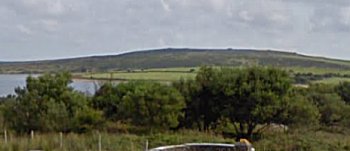 Brown Gelly is one of those hills you can see from miles around. Five cairns are located along the ridge of Brown Gelly which runs roughly north south and rises to 1122 feet. There are views over Dozmary Pool, Colliford Lake, Siblyback Lake and the Fowey River.
Brown Gelly is one of those hills you can see from miles around. Five cairns are located along the ridge of Brown Gelly which runs roughly north south and rises to 1122 feet. There are views over Dozmary Pool, Colliford Lake, Siblyback Lake and the Fowey River.
Brown Willy
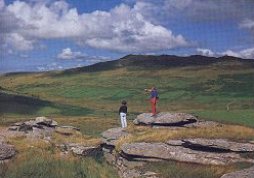 The highest hill in Cornwall is 1377 feet. Situated in the centre of the moor to the north of the A30 road, about 2.5 miles north-west of Bolventor, it dominates the moorland scene. The source of the River Fowey is nearby and its height causes a rain shadow downwind. There are hut circles and tumuli on the slopes about its long-ridged peak. It has a wonderfully remote atmosphere and on a very clear day you can see as far as Lundy Island and Exmoor to the north, Trevose Head to the west and St. Austell to the south.
The highest hill in Cornwall is 1377 feet. Situated in the centre of the moor to the north of the A30 road, about 2.5 miles north-west of Bolventor, it dominates the moorland scene. The source of the River Fowey is nearby and its height causes a rain shadow downwind. There are hut circles and tumuli on the slopes about its long-ridged peak. It has a wonderfully remote atmosphere and on a very clear day you can see as far as Lundy Island and Exmoor to the north, Trevose Head to the west and St. Austell to the south.
Caradon Hill
 The 800 foot television mast erected in 1961 which rises above the tumuli and roofless mine buildings of this ancient hill, can be seen for many miles around, and is about four miles north of Liskeard. Reaching 1213 feet, the hill provides a useful landmark for those moorland walkers who are not expert map-readers. During the Civil War King Charles I, accompanied by Prince Maurice, mustered his troops here on the 2nd August 1644 before they went on to a notable victory at Castle Dore. Copper was discovered here in 1837, and signalled the beginning of the boom which changed the character of the eastern moor. There are the remains of mines and mining everywhere. Thousands of people once worked the mines here. The track of the old mineral railway line can still be traced contouring around the hill. On the south-eastern slope of the hill is Tokenbury Corner, a large piece of open common land with amazing views across all of south east cornwall. The mining villages of Pensilva, Crows Nest, Darite, Minions and Upton Cross are all situated around the base of the hill.
The 800 foot television mast erected in 1961 which rises above the tumuli and roofless mine buildings of this ancient hill, can be seen for many miles around, and is about four miles north of Liskeard. Reaching 1213 feet, the hill provides a useful landmark for those moorland walkers who are not expert map-readers. During the Civil War King Charles I, accompanied by Prince Maurice, mustered his troops here on the 2nd August 1644 before they went on to a notable victory at Castle Dore. Copper was discovered here in 1837, and signalled the beginning of the boom which changed the character of the eastern moor. There are the remains of mines and mining everywhere. Thousands of people once worked the mines here. The track of the old mineral railway line can still be traced contouring around the hill. On the south-eastern slope of the hill is Tokenbury Corner, a large piece of open common land with amazing views across all of south east cornwall. The mining villages of Pensilva, Crows Nest, Darite, Minions and Upton Cross are all situated around the base of the hill.
The Cheesewring
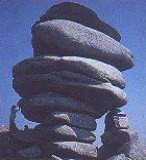 A natural formation of much-photographed balancing rocks on Stowe's Hill standing 32 feet high, 1210 feet above sea level, and located close to Minions village. From this spot there is a magnificent view over the Tamar Valley to the east and open moorland to the west. Close at hand is the long-neglected Cheesewring quarry, Daniel Gumb's 'house', and the Iron Age fort known as Stowe's Pound. A short distance across the moor to the west is 'the gold diggings'. Gold was found in the mines and rivers on the moor, but in no great quantities. This was a favourite outing for Sunday schools in the 19th century, when the children would travel here on the old mineral railway, to the quarry which was started in 1839. Today the quarries which once sent tons of granite down the railway to Liskeard and Looe, are only used by climbers.
A natural formation of much-photographed balancing rocks on Stowe's Hill standing 32 feet high, 1210 feet above sea level, and located close to Minions village. From this spot there is a magnificent view over the Tamar Valley to the east and open moorland to the west. Close at hand is the long-neglected Cheesewring quarry, Daniel Gumb's 'house', and the Iron Age fort known as Stowe's Pound. A short distance across the moor to the west is 'the gold diggings'. Gold was found in the mines and rivers on the moor, but in no great quantities. This was a favourite outing for Sunday schools in the 19th century, when the children would travel here on the old mineral railway, to the quarry which was started in 1839. Today the quarries which once sent tons of granite down the railway to Liskeard and Looe, are only used by climbers.
Colliford Lake
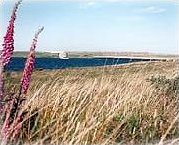 Not far west of Siblyback and overlooked by Brown Gelly is the 900 acre Colliford Reservoir situated just south of Jamaica Inn, the famous smugglers' haunt immortalised by Daphne Du Maurier. Colliford is a tranquil place with ample car parking and plenty of space for picnics and lakeside walks. There are three way-marked walks starting from the main car park which include the neighbouring moorland. The large Nature Reserve has become an important site for over-wintering wildfowl. The lake offers traditional fly fishing for natural brown trout and is regarded as Cornwall's premier brown trout fishery. The reservoir was constructed in 1982 and flooded in 1984. The water drops off the moor as the St. Neot River, flowing down through the village of St. Neot before joining the River Fowey. Now managed by the South West Lakes Trust as Colliford Lake.
Not far west of Siblyback and overlooked by Brown Gelly is the 900 acre Colliford Reservoir situated just south of Jamaica Inn, the famous smugglers' haunt immortalised by Daphne Du Maurier. Colliford is a tranquil place with ample car parking and plenty of space for picnics and lakeside walks. There are three way-marked walks starting from the main car park which include the neighbouring moorland. The large Nature Reserve has become an important site for over-wintering wildfowl. The lake offers traditional fly fishing for natural brown trout and is regarded as Cornwall's premier brown trout fishery. The reservoir was constructed in 1982 and flooded in 1984. The water drops off the moor as the St. Neot River, flowing down through the village of St. Neot before joining the River Fowey. Now managed by the South West Lakes Trust as Colliford Lake.
Crowdy Reservoir
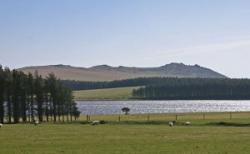 Crowdy Reservoir constructed in 1973 and some 115 acres in size is located on the west side of the moor, two miles east of Camelford, and has fishing and leisure/sport activities managed by the South West Lakes Trust. The area around Crowdy Reservoir and Davidstow woods are designated a 'Site of Special Scientific Interest', particularly noted for the very wide species of birds that are to be seen here. The old war time airfield of Davidstow and its museum is nearby.
Crowdy Reservoir constructed in 1973 and some 115 acres in size is located on the west side of the moor, two miles east of Camelford, and has fishing and leisure/sport activities managed by the South West Lakes Trust. The area around Crowdy Reservoir and Davidstow woods are designated a 'Site of Special Scientific Interest', particularly noted for the very wide species of birds that are to be seen here. The old war time airfield of Davidstow and its museum is nearby.
Daniel Gumb's Cave
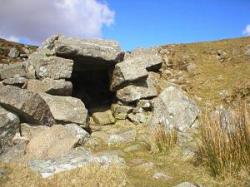 Located close to Cheesewring Quarry, near Minions, Daniel Gumb was born in 1703, when he grew up and worked at the quarry, he built himself a stone 'cave' near the bottom of the quarry. You can still see the place though much reduced from the original three room thirty foot long 'house'. In this house he and his wife raised nine children, he carved his name and date 1735 into a stone, and because he was interested in astronomy also carved out mathematical signs into the long stone that served as a roof. When the Cheesewring quarry was started in the mid 1800's the home was broken up, Daniel Gumb had died in 1776 and many of his offspring have emigrated to the Americas. What remains now is only a small part of the original. Some of his work as a stone mason can be found on tombstones in several local graveyards including that at Linkinhorne.
Located close to Cheesewring Quarry, near Minions, Daniel Gumb was born in 1703, when he grew up and worked at the quarry, he built himself a stone 'cave' near the bottom of the quarry. You can still see the place though much reduced from the original three room thirty foot long 'house'. In this house he and his wife raised nine children, he carved his name and date 1735 into a stone, and because he was interested in astronomy also carved out mathematical signs into the long stone that served as a roof. When the Cheesewring quarry was started in the mid 1800's the home was broken up, Daniel Gumb had died in 1776 and many of his offspring have emigrated to the Americas. What remains now is only a small part of the original. Some of his work as a stone mason can be found on tombstones in several local graveyards including that at Linkinhorne.
Dozmary Pool
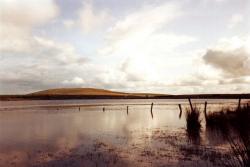 About thirty acres in extent and 885 feet above sea level, this dark and lonely place has always fascinated local inhabitants and visitors alike. Its shores were probably inhabited before any other inland area of Cornwall. Associated with the legend of King Arthur and with Excalibur, King Arthur's sword given to him by the Lady of the Lake. It is said that after Arthur was mortally wounded he ordered that Excalibur be thrown into the lake. This was done and after the sword was cast into the lake a woman's hand caught it and held it aloft before taking it under the surface. And the ghost of Jan Tregeagle, who to keep his soul from the Devil was set a series of impossible tasks. The first was to empty Dozmary Pool with a holed limpet shell. It has since been proved that the lake does have a bottom as it dried out during the last century! - Dozmary lies just south of Bolventor and the famous Jamaica Inn. An ice making industry was once carried out here, the remnants of the old landing stages are still visible. The pool outfalls into Colliford Lake.
About thirty acres in extent and 885 feet above sea level, this dark and lonely place has always fascinated local inhabitants and visitors alike. Its shores were probably inhabited before any other inland area of Cornwall. Associated with the legend of King Arthur and with Excalibur, King Arthur's sword given to him by the Lady of the Lake. It is said that after Arthur was mortally wounded he ordered that Excalibur be thrown into the lake. This was done and after the sword was cast into the lake a woman's hand caught it and held it aloft before taking it under the surface. And the ghost of Jan Tregeagle, who to keep his soul from the Devil was set a series of impossible tasks. The first was to empty Dozmary Pool with a holed limpet shell. It has since been proved that the lake does have a bottom as it dried out during the last century! - Dozmary lies just south of Bolventor and the famous Jamaica Inn. An ice making industry was once carried out here, the remnants of the old landing stages are still visible. The pool outfalls into Colliford Lake.
Fore Down
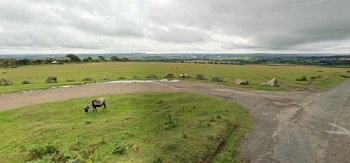 Large area of common land at the south-east corner of Caradon Hill just above Pensilva. The views are amazing from here, on a clear day you can see to the coast from Plymouth to St. Austell. The B3254 road to the south goes to Liskeard and the road to the west goes to Crows Nest on the edge of Bodmin Moor.
Large area of common land at the south-east corner of Caradon Hill just above Pensilva. The views are amazing from here, on a clear day you can see to the coast from Plymouth to St. Austell. The B3254 road to the south goes to Liskeard and the road to the west goes to Crows Nest on the edge of Bodmin Moor.
Fox Tor
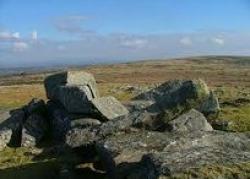 Easily accessible from the road above Altarnun, this tor rising to 1129 feet on the northern edge of East Moor gives excellent views in most directions. The small stone circle of Nine Stones is nearby.
Easily accessible from the road above Altarnun, this tor rising to 1129 feet on the northern edge of East Moor gives excellent views in most directions. The small stone circle of Nine Stones is nearby.
Garrow Tor
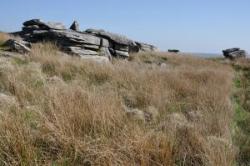 At the summit of Garrow Tor which reaches 1080 feet and is about two miles north-west of Bolventor, are granite rock outcrops and panoramic views, including Caradon Hill to the south, Rough Tor and Brown Willy to the north, Butter's Tor to the east, clay country to the west and the Atlantic Ocean to the north-west. The hill also bears extensive evidence of early settlement, including a massive stone hedge, Bronze Age settlements and hut circles and Medieval settlements. The De Lank River runs past the eastern flank of the tor from north to south, before swinging south-west around the southern foot of the hill. King Arthur's Hall lies half a mile to the south-west. The remains of Garrow farm are still standing on the east side of the hill.
At the summit of Garrow Tor which reaches 1080 feet and is about two miles north-west of Bolventor, are granite rock outcrops and panoramic views, including Caradon Hill to the south, Rough Tor and Brown Willy to the north, Butter's Tor to the east, clay country to the west and the Atlantic Ocean to the north-west. The hill also bears extensive evidence of early settlement, including a massive stone hedge, Bronze Age settlements and hut circles and Medieval settlements. The De Lank River runs past the eastern flank of the tor from north to south, before swinging south-west around the southern foot of the hill. King Arthur's Hall lies half a mile to the south-west. The remains of Garrow farm are still standing on the east side of the hill.
Golitha Falls
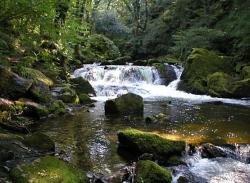 Situated close to Draynes Bridge, just off the St. Neot road, Golitha Falls is a well known local beauty spot, where the River Fowey drops through an attractive wooded valley in a series of falls as though anxious to leave the moor behind. It is carpeted with bluebells in the spring and with mushrooms in the autumn. There is a car park and toilets by the road leading to a level riverside walk. The bridge was built in 1876 to replace an earlier ford. Beside the path in the woods can be seen the massive walls built in the 1850's to take the water wheel used in the Wheal Victoria Mine. Now a National Nature Reserve. The reserve is home to dormice which reside in the ancient hazel coppice. Noctule, brown long-eared and lesser horseshoe bats have been recorded. Dippers can be seen bobbing in the river, with nuthatch, tree-creeper and pied flycatcher joining more common birds in the dawn chorus. The river also supports healthy populations of both salmon and sea trout which in turn provides opportunities for fly fishing. Otters are often seen exploring the falls. Inkie's Smokehouse BBQ, which is based next to the beautiful Golitha Falls nature reserve has a growing reputation for its smoked meats, burgers and wraps. Much of the area was improved in 1993 to facilitate the filming of a scene for the Disney version of The Three Musketeers.
Situated close to Draynes Bridge, just off the St. Neot road, Golitha Falls is a well known local beauty spot, where the River Fowey drops through an attractive wooded valley in a series of falls as though anxious to leave the moor behind. It is carpeted with bluebells in the spring and with mushrooms in the autumn. There is a car park and toilets by the road leading to a level riverside walk. The bridge was built in 1876 to replace an earlier ford. Beside the path in the woods can be seen the massive walls built in the 1850's to take the water wheel used in the Wheal Victoria Mine. Now a National Nature Reserve. The reserve is home to dormice which reside in the ancient hazel coppice. Noctule, brown long-eared and lesser horseshoe bats have been recorded. Dippers can be seen bobbing in the river, with nuthatch, tree-creeper and pied flycatcher joining more common birds in the dawn chorus. The river also supports healthy populations of both salmon and sea trout which in turn provides opportunities for fly fishing. Otters are often seen exploring the falls. Inkie's Smokehouse BBQ, which is based next to the beautiful Golitha Falls nature reserve has a growing reputation for its smoked meats, burgers and wraps. Much of the area was improved in 1993 to facilitate the filming of a scene for the Disney version of The Three Musketeers.
The Hurlers
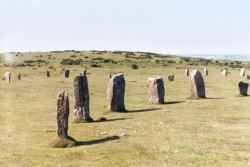 On the edge of the village of Minions. Originally the stones here formed part of three circles, erected about 1500 BC. They are probably the best known stone circles on the moor because they are so readily accessible. Built within a relatively short time of Stonehenge, many theories have been put forward about the uses to which they were put. They have been variously described as places of human sacrifice, and a meeting place for moorland chiefs. Legend has it that the stones were once men and women, turned to stone for playing the ancient game of hurling on a Sunday - hence the name. Two other monoliths, the Pipers, are 330 feet south-west of the middle circle and may be entrance stones to the Hurlers.
On the edge of the village of Minions. Originally the stones here formed part of three circles, erected about 1500 BC. They are probably the best known stone circles on the moor because they are so readily accessible. Built within a relatively short time of Stonehenge, many theories have been put forward about the uses to which they were put. They have been variously described as places of human sacrifice, and a meeting place for moorland chiefs. Legend has it that the stones were once men and women, turned to stone for playing the ancient game of hurling on a Sunday - hence the name. Two other monoliths, the Pipers, are 330 feet south-west of the middle circle and may be entrance stones to the Hurlers.
Jubilee Rock
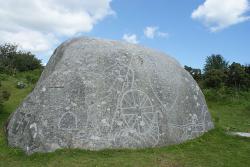 The massive eight foot high granite boulder just north of Blisland was said to have been carved by Lieutenant John Rogers to celebrate the 1810 Golden Jubilee of King George III. In 1897 an addition was made for Queen Victoria's Golden Jubilee. The carvings were restored for the 2012 Diamond Jubilee of Queen Elizabeth II.
The massive eight foot high granite boulder just north of Blisland was said to have been carved by Lieutenant John Rogers to celebrate the 1810 Golden Jubilee of King George III. In 1897 an addition was made for Queen Victoria's Golden Jubilee. The carvings were restored for the 2012 Diamond Jubilee of Queen Elizabeth II.
Kerdroya
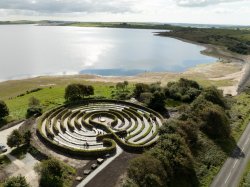 A labyrinth on Bodmin Moor made of nearly 1475 feet of Cornish hedging - which combines stone and vegetation. The monument's creator, Will Coleman, spent five years developing the project - which is made of more than 140,000 granite stones. The project was built by master craftsmen and apprentices as a way to pass on traditional stone hedging techniques. At the heart of Kerdroya is a metal art installation that reflects the shape of the labyrinth and has been crafted by Thomas and Gary Thrussell, father and son metal artists, who live half a mile away from the site. After many delays due to bad weather it finally opened on March 21st 2025.
A labyrinth on Bodmin Moor made of nearly 1475 feet of Cornish hedging - which combines stone and vegetation. The monument's creator, Will Coleman, spent five years developing the project - which is made of more than 140,000 granite stones. The project was built by master craftsmen and apprentices as a way to pass on traditional stone hedging techniques. At the heart of Kerdroya is a metal art installation that reflects the shape of the labyrinth and has been crafted by Thomas and Gary Thrussell, father and son metal artists, who live half a mile away from the site. After many delays due to bad weather it finally opened on March 21st 2025.
Kilmar Tor
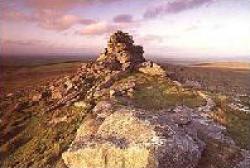 A long ridge of broken and balancing granite rocks lying roughly east-west at a height of 1295 feet. Here is the true essence of Bodmin Moor. Majesty, timelessness, loneliness - and sheer beauty. Great views both north and south across the moor. Here is also where the railway which carried granite down from the quarries, ends, having climbed up across the moors from Liskeard and Looe via Minions.
A long ridge of broken and balancing granite rocks lying roughly east-west at a height of 1295 feet. Here is the true essence of Bodmin Moor. Majesty, timelessness, loneliness - and sheer beauty. Great views both north and south across the moor. Here is also where the railway which carried granite down from the quarries, ends, having climbed up across the moors from Liskeard and Looe via Minions.
King Arthur's Bed
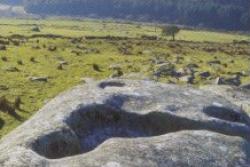 On the western edge of Trewortha Tor and looking out across Twelvemens Moor. King Arthur's 'bed' is a huge block of stone, sculptured by wind and rain into a shape that is more evocative of a granite coffin than a bed.
On the western edge of Trewortha Tor and looking out across Twelvemens Moor. King Arthur's 'bed' is a huge block of stone, sculptured by wind and rain into a shape that is more evocative of a granite coffin than a bed.
King Arthur's Hall
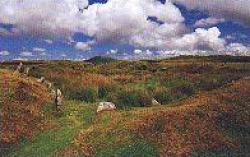 A rectangular enclosure measuring 158 x 65 feet. Here and there a flat moorstone still stands to remind us that they once formed the walls about this 'building'. Its origins and purpose are as mysterious as the moor itself. It is sited on King Arthur's Downs, close to Garrow Tor - a hill with a wealth of history. Explanations put forward for this enclosure include its use as a cattle pound, or as a reservoir - hardly likely in view of the amount of water readily available nearby. Traditionally, it is as its name implies, the hall of King Arthur. Historians pour scorn on the legend of Arthur - but it is remarkably persistent.
A rectangular enclosure measuring 158 x 65 feet. Here and there a flat moorstone still stands to remind us that they once formed the walls about this 'building'. Its origins and purpose are as mysterious as the moor itself. It is sited on King Arthur's Downs, close to Garrow Tor - a hill with a wealth of history. Explanations put forward for this enclosure include its use as a cattle pound, or as a reservoir - hardly likely in view of the amount of water readily available nearby. Traditionally, it is as its name implies, the hall of King Arthur. Historians pour scorn on the legend of Arthur - but it is remarkably persistent.
King Doniert's Stone
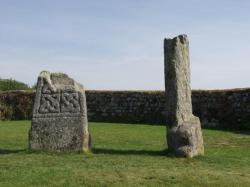 At the side of the road between Redgate and Minions. The inscription, in Latin, tells us that the stone was erected for the good of King Doniert's soul. Doniert is mentioned in the Anglo-Saxon Chronicle as being a Cornish King, or chieftain, who was accidentally drowned in the nearby River Fowey in 878 AD. He is reputed to be the last Cornish King, but this honour probably goes to King Ricatus who ruled in Cornwall's far west in the 10th century. The beauty spot of Golitha Falls is nearby.
At the side of the road between Redgate and Minions. The inscription, in Latin, tells us that the stone was erected for the good of King Doniert's soul. Doniert is mentioned in the Anglo-Saxon Chronicle as being a Cornish King, or chieftain, who was accidentally drowned in the nearby River Fowey in 878 AD. He is reputed to be the last Cornish King, but this honour probably goes to King Ricatus who ruled in Cornwall's far west in the 10th century. The beauty spot of Golitha Falls is nearby.
Nine Stones
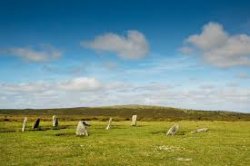 This is an attractive circle in a very peaceful location. This is a perfect circle of eight outer stones plus a centre one and is the smallest circle on the moor at fifteen yards diameter. It is an English Heritage managed property. It was restored in 1889 when only two stones remained standing. About two miles south-east of Altarnun.
This is an attractive circle in a very peaceful location. This is a perfect circle of eight outer stones plus a centre one and is the smallest circle on the moor at fifteen yards diameter. It is an English Heritage managed property. It was restored in 1889 when only two stones remained standing. About two miles south-east of Altarnun.
The Longstone
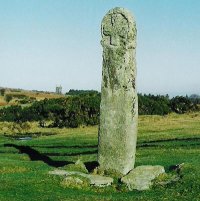 Known locally as 'Long Tom', the Longstone stands a few yards from the road, on Craddock Moor, south of Minions. This is just one of the dozens of similar stones scattered the length and breadth of the moor. Its position affords the visitor ample opportunity to stop and appreciate the atmosphere surrounding this weathered, cross-inscribed stone, 'Standing alone on a hill of storms'.
Known locally as 'Long Tom', the Longstone stands a few yards from the road, on Craddock Moor, south of Minions. This is just one of the dozens of similar stones scattered the length and breadth of the moor. Its position affords the visitor ample opportunity to stop and appreciate the atmosphere surrounding this weathered, cross-inscribed stone, 'Standing alone on a hill of storms'.
Rillaton Barrow
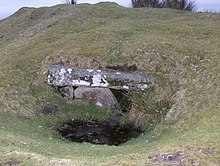 A very large Early Bronze Age barrow, two hundred yards north-east of 'The Hurlers'. The barrow is approximately thirty yards in diameter. An excavation by local miners in 1837 discovered a granite cyst set in its eastern edge. The site of the cist is still visible in the side of the barrow. The cist contained the remains of a human skeleton, beads, spear head, pottery and the 'Rillaton' Gold Cup, now held in the British Museum. A copy can be seen in the Royal Cornwall Museum, in Truro. Most notably, the burial contained, a bi-conical gold vessel, about three and a half inches high, with a handle attached with rivets. The cup resembles a late Neolithic (approx 2300 BC) ceramic beaker with corded decoration.
A very large Early Bronze Age barrow, two hundred yards north-east of 'The Hurlers'. The barrow is approximately thirty yards in diameter. An excavation by local miners in 1837 discovered a granite cyst set in its eastern edge. The site of the cist is still visible in the side of the barrow. The cist contained the remains of a human skeleton, beads, spear head, pottery and the 'Rillaton' Gold Cup, now held in the British Museum. A copy can be seen in the Royal Cornwall Museum, in Truro. Most notably, the burial contained, a bi-conical gold vessel, about three and a half inches high, with a handle attached with rivets. The cup resembles a late Neolithic (approx 2300 BC) ceramic beaker with corded decoration.
Rough Tor
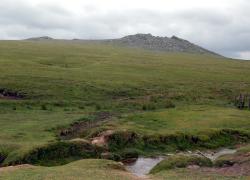 Owned by the National Trust, this is one feature of the moor which should remain unchanged for posterity. In the 19th-century the hill was known as Router and even into the late 20th century some locals used this pronunciation. At 1311 feet it is the second highest hill on the moor and is wonderfully remote and unspoilt and only one mile north-west of Brown Willy. The De Lank River rises nearby and flows between the two hills, Rough Tor and Little Rough Tor. The summit of the tor was once the site of a medieval chapel, which was built into the side of one of the cairns, and was dedicated to St. Michael. The chapel was recorded in the 14th century, and is the only known hilltop chapel on Bodmin Moor. As it overlooks an ancient trackway across the moor, it may have served as a guide for travellers. There are the remains of a Bronze Age settlements around the hill. Charlotte Dymond was murdered here in 1844 and a memorial to her stands somewhat forlornly at the foot of the slope. Her murderer Matthew Weeks was hanged in Bodmin Jail in front of a crowd of 20,000. Roughtor was presented to the nation in memory of those who lost their lives while serving in 43rd (Wessex) Division in the North West European campaign 1944-5. The Holy Well of St. Michael on the slopes of Rough Tor, was rediscovered and restored in 1994. In a programme shown in 2007 Channel 4's Time Team investigated a 500-metre cairn and the site of a Bronze Age village on the slopes of Rough Tor. Rough Tor features in Daphne du Maurier's novel Jamaica Inn. Rough Tor is best approached over the small bridge by the car park at the end of the road from Camelford.
Owned by the National Trust, this is one feature of the moor which should remain unchanged for posterity. In the 19th-century the hill was known as Router and even into the late 20th century some locals used this pronunciation. At 1311 feet it is the second highest hill on the moor and is wonderfully remote and unspoilt and only one mile north-west of Brown Willy. The De Lank River rises nearby and flows between the two hills, Rough Tor and Little Rough Tor. The summit of the tor was once the site of a medieval chapel, which was built into the side of one of the cairns, and was dedicated to St. Michael. The chapel was recorded in the 14th century, and is the only known hilltop chapel on Bodmin Moor. As it overlooks an ancient trackway across the moor, it may have served as a guide for travellers. There are the remains of a Bronze Age settlements around the hill. Charlotte Dymond was murdered here in 1844 and a memorial to her stands somewhat forlornly at the foot of the slope. Her murderer Matthew Weeks was hanged in Bodmin Jail in front of a crowd of 20,000. Roughtor was presented to the nation in memory of those who lost their lives while serving in 43rd (Wessex) Division in the North West European campaign 1944-5. The Holy Well of St. Michael on the slopes of Rough Tor, was rediscovered and restored in 1994. In a programme shown in 2007 Channel 4's Time Team investigated a 500-metre cairn and the site of a Bronze Age village on the slopes of Rough Tor. Rough Tor features in Daphne du Maurier's novel Jamaica Inn. Rough Tor is best approached over the small bridge by the car park at the end of the road from Camelford.
Sharptor
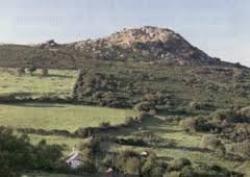 Physically one of the smallest tors when viewed from the moor itself, Sharptor is most spectacular when viewed from Henwood village. Easily accessible, but it still reaches 1066 feet, and is located about one mile north of Minions, it commands a breath-taking view of the whole of East Cornwall - and beyond. On a clear day it is possible to see the sea both to north and south. Originally known as Sharp Point Tor, it is distinguishable from many miles away.
Physically one of the smallest tors when viewed from the moor itself, Sharptor is most spectacular when viewed from Henwood village. Easily accessible, but it still reaches 1066 feet, and is located about one mile north of Minions, it commands a breath-taking view of the whole of East Cornwall - and beyond. On a clear day it is possible to see the sea both to north and south. Originally known as Sharp Point Tor, it is distinguishable from many miles away.
Siblyback Reservoir
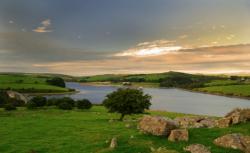 A man-made lake located about one mile west of Minions, the dam was completed in 1969. Covering 140 acres and well-stocked with fish, this is a popular place with anglers and boating enthusiasts, but it is rarely uncomfortably crowded. In winter the reservoir becomes a lonely part of the moor, providing a haven for a large variety of birds, some resident, others casual visitors. The overflow from the reservoir runs into the River Fowey just above Golitha Falls. Managed by the South West Lakes Trust. Now run as the Siblyback Lake Country Park.
A man-made lake located about one mile west of Minions, the dam was completed in 1969. Covering 140 acres and well-stocked with fish, this is a popular place with anglers and boating enthusiasts, but it is rarely uncomfortably crowded. In winter the reservoir becomes a lonely part of the moor, providing a haven for a large variety of birds, some resident, others casual visitors. The overflow from the reservoir runs into the River Fowey just above Golitha Falls. Managed by the South West Lakes Trust. Now run as the Siblyback Lake Country Park.
Stowe's Pound
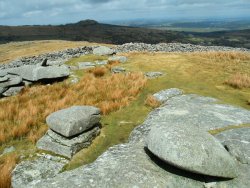 An elongated hill, 1,250 feet high, located on the eastern edge of Bodmin Moor. Stowe's Hill is a prominent granite ridge located about one mile north of Minions. It is dominated by Stowe's Pound, a huge tor enclosure comprising two massive stone-walls. The smaller enclosure surrounds the tors at the southern end of the hill; the larger one encircles the rest of the ridge. At the southern end is a large, disused quarry, but the hill is best known as the site of the Cheesewring, the extraordinary granite formation that gave the quarry its name. Inside Stowe's Pound are two Bronze Age cairns, a stone round house and over 100 house platforms. The site is thought to be Neolithic or Bronze Age and connected with other settlements and ritual monuments in the vicinity.
An elongated hill, 1,250 feet high, located on the eastern edge of Bodmin Moor. Stowe's Hill is a prominent granite ridge located about one mile north of Minions. It is dominated by Stowe's Pound, a huge tor enclosure comprising two massive stone-walls. The smaller enclosure surrounds the tors at the southern end of the hill; the larger one encircles the rest of the ridge. At the southern end is a large, disused quarry, but the hill is best known as the site of the Cheesewring, the extraordinary granite formation that gave the quarry its name. Inside Stowe's Pound are two Bronze Age cairns, a stone round house and over 100 house platforms. The site is thought to be Neolithic or Bronze Age and connected with other settlements and ritual monuments in the vicinity.
Temple Church
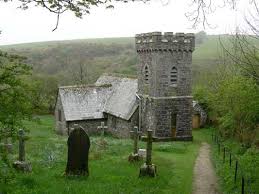 Once the Gretna Green of Cornwall, earning much of its income from marriages and burials. This settlement high on Bodmin Moor, just off the A30 road was founded by the Knights Templar in 1120 as a hospice for travellers. The little church built by the Knights fell into disrepair many years ago, but was re-built in 1883 on the original pattern as St. Catherine's by Silvanus Trevail. It is a stark little building, tucked away in a quiet valley but still serving its sparse community at Temple.
Once the Gretna Green of Cornwall, earning much of its income from marriages and burials. This settlement high on Bodmin Moor, just off the A30 road was founded by the Knights Templar in 1120 as a hospice for travellers. The little church built by the Knights fell into disrepair many years ago, but was re-built in 1883 on the original pattern as St. Catherine's by Silvanus Trevail. It is a stark little building, tucked away in a quiet valley but still serving its sparse community at Temple.
Tregarrick Tor
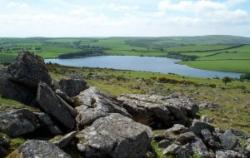 A much under visited tor with excellent views over Siblyback Lake Country Park. Sitting at 1036 feet above sea level and not far from the Hurlers stone circles and the Cheesewring, it has a wonderfully remote atmosphere. Located about one mile west of Minions.
A much under visited tor with excellent views over Siblyback Lake Country Park. Sitting at 1036 feet above sea level and not far from the Hurlers stone circles and the Cheesewring, it has a wonderfully remote atmosphere. Located about one mile west of Minions.
Trethevy Quoit
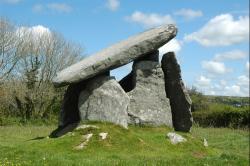 Close to Tremar, in St. Cleer parish, this is a well-preserved and impressive Chamber Tomb of the Megalithic period (3500 BC) and undoubtedly one of the finest in the county. Originally covered in earth to form a burial mound, this tomb would once have held the body of an important member of a primitive and superstitious community. Also known as King Arthur's Quoit.
Close to Tremar, in St. Cleer parish, this is a well-preserved and impressive Chamber Tomb of the Megalithic period (3500 BC) and undoubtedly one of the finest in the county. Originally covered in earth to form a burial mound, this tomb would once have held the body of an important member of a primitive and superstitious community. Also known as King Arthur's Quoit.
Trewortha Bronze Age Farm
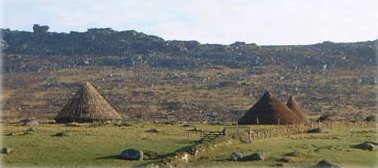 The Bronze Age Village at Trewortha is attached to the Trewortha Farm Centre near North Hill. It consists of Bronze Age roundhouse reconstructions on privately owned land, used for education purposes. It sits in the valley between Kilmar Tor and Trewortha Tor.
The Bronze Age Village at Trewortha is attached to the Trewortha Farm Centre near North Hill. It consists of Bronze Age roundhouse reconstructions on privately owned land, used for education purposes. It sits in the valley between Kilmar Tor and Trewortha Tor.
Carnglaze Slate Caverns Jamaica Inn Wesley Cottage Beast of Bodmin The Caradon Trail Crowdy Reservoir
Colliford Lake Dobwalls Family Adventure Park Sterts Theatre and Arts Centre Siblyback Lake Country Park
Altarnun Blisland Bodmin Bolventor Cardinham Woods Launceston Liskeard Minions North Hill Temple
Cardinham St. Breward St. Neot St. Cleer Cornwall at War Museum Davidstow Moor RAF Memorial Museum Linkinhorne
Ancient Sites in Cornwall The Copper Trail Cornwall's History Mining in Cornwall Horse Riding in Cornwall Forestry Walks in Cornwall
 Brown Gelly is one of those hills you can see from miles around. Five cairns are located along the ridge of Brown Gelly which runs roughly north south and rises to 1122 feet. There are views over Dozmary Pool, Colliford Lake, Siblyback Lake and the Fowey River.
Brown Gelly is one of those hills you can see from miles around. Five cairns are located along the ridge of Brown Gelly which runs roughly north south and rises to 1122 feet. There are views over Dozmary Pool, Colliford Lake, Siblyback Lake and the Fowey River.

 The highest hill in Cornwall is 1377 feet. Situated in the centre of the moor to the north of the
The highest hill in Cornwall is 1377 feet. Situated in the centre of the moor to the north of the  The 800 foot television mast erected in
The 800 foot television mast erected in  A natural formation of much-photographed balancing rocks on Stowe's Hill standing 32 feet high, 1210 feet above sea level, and located close to
A natural formation of much-photographed balancing rocks on Stowe's Hill standing 32 feet high, 1210 feet above sea level, and located close to  Not far west of
Not far west of 
 Located close to
Located close to  About thirty acres in extent and 885 feet above sea level, this dark and lonely place has always fascinated local inhabitants and visitors alike. Its shores were probably inhabited before any other inland area of Cornwall. Associated with the legend of
About thirty acres in extent and 885 feet above sea level, this dark and lonely place has always fascinated local inhabitants and visitors alike. Its shores were probably inhabited before any other inland area of Cornwall. Associated with the legend of  Large area of common land at the south-east corner of
Large area of common land at the south-east corner of  Easily accessible from the road above
Easily accessible from the road above  At the summit of Garrow Tor which reaches 1080 feet and is about two miles north-west of
At the summit of Garrow Tor which reaches 1080 feet and is about two miles north-west of  Situated close to
Situated close to  On the edge of the village of
On the edge of the village of  The massive eight foot high granite boulder just north of
The massive eight foot high granite boulder just north of  A labyrinth on Bodmin Moor made of nearly 1475 feet of Cornish hedging - which combines stone and vegetation. The monument's creator, Will Coleman, spent five years developing the project - which is made of more than 140,000 granite stones. The project was built by master craftsmen and apprentices as a way to pass on traditional stone hedging techniques. At the heart of Kerdroya is a metal art installation that reflects the shape of the labyrinth and has been crafted by Thomas and Gary Thrussell, father and son metal artists, who live half a mile away from the site. After many delays due to bad weather it finally opened on March 21st
A labyrinth on Bodmin Moor made of nearly 1475 feet of Cornish hedging - which combines stone and vegetation. The monument's creator, Will Coleman, spent five years developing the project - which is made of more than 140,000 granite stones. The project was built by master craftsmen and apprentices as a way to pass on traditional stone hedging techniques. At the heart of Kerdroya is a metal art installation that reflects the shape of the labyrinth and has been crafted by Thomas and Gary Thrussell, father and son metal artists, who live half a mile away from the site. After many delays due to bad weather it finally opened on March 21st  A long ridge of broken and balancing granite rocks lying roughly east-west at a height of 1295 feet. Here is the true essence of Bodmin Moor. Majesty, timelessness, loneliness - and sheer beauty. Great views both north and south across the moor. Here is also where the
A long ridge of broken and balancing granite rocks lying roughly east-west at a height of 1295 feet. Here is the true essence of Bodmin Moor. Majesty, timelessness, loneliness - and sheer beauty. Great views both north and south across the moor. Here is also where the  On the western edge of Trewortha Tor and looking out across Twelvemens Moor.
On the western edge of Trewortha Tor and looking out across Twelvemens Moor.  A rectangular enclosure measuring 158 x 65 feet. Here and there a flat moorstone still stands to remind us that they once formed the walls about this 'building'. Its origins and purpose are as mysterious as the moor itself. It is sited on
A rectangular enclosure measuring 158 x 65 feet. Here and there a flat moorstone still stands to remind us that they once formed the walls about this 'building'. Its origins and purpose are as mysterious as the moor itself. It is sited on  At the side of the road between Redgate and
At the side of the road between Redgate and  This is an attractive circle in a very peaceful location. This is a perfect circle of eight outer stones plus a centre one and is the smallest circle on the moor at fifteen yards diameter. It is an
This is an attractive circle in a very peaceful location. This is a perfect circle of eight outer stones plus a centre one and is the smallest circle on the moor at fifteen yards diameter. It is an  Known locally as 'Long Tom', the Longstone stands a few yards from the road, on Craddock Moor, south of
Known locally as 'Long Tom', the Longstone stands a few yards from the road, on Craddock Moor, south of  A very large Early Bronze Age barrow, two hundred yards north-east of '
A very large Early Bronze Age barrow, two hundred yards north-east of ' Owned by the
Owned by the  Physically one of the smallest tors when viewed from the moor itself, Sharptor is most spectacular when viewed from Henwood village. Easily accessible, but it still reaches 1066 feet, and is located about one mile north of
Physically one of the smallest tors when viewed from the moor itself, Sharptor is most spectacular when viewed from Henwood village. Easily accessible, but it still reaches 1066 feet, and is located about one mile north of  A man-made lake located about one mile west of
A man-made lake located about one mile west of  An elongated hill, 1,250 feet high, located on the eastern edge of Bodmin Moor. Stowe's Hill is a prominent granite ridge located about one mile north of
An elongated hill, 1,250 feet high, located on the eastern edge of Bodmin Moor. Stowe's Hill is a prominent granite ridge located about one mile north of  Once the Gretna Green of Cornwall, earning much of its income from marriages and burials. This settlement high on
Once the Gretna Green of Cornwall, earning much of its income from marriages and burials. This settlement high on  A much under visited tor with excellent views over
A much under visited tor with excellent views over  Close to Tremar, in
Close to Tremar, in  The Bronze Age Village at Trewortha is attached to the Trewortha Farm Centre near
The Bronze Age Village at Trewortha is attached to the Trewortha Farm Centre near 
